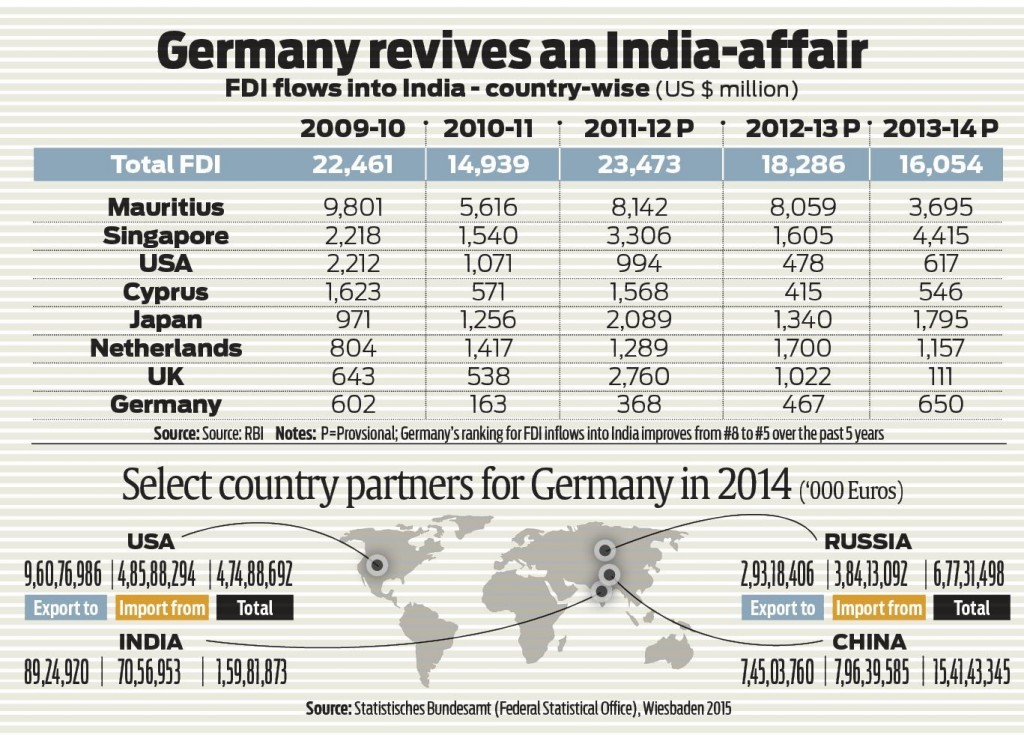R N Bhaskar
6 July 2015
For almost four decades since India’s independence, Germany saw immense opportunity in this country. True, there were hurdles. Managing the government wasn’t easy. Especially when many of the big businesses that Germany was interested in were government-controlled then. This was true of telecom, power generation, transmission and distribution, railways and signalling, among others.
But Germany still managed to get along. India, in turn, lapped up its technologies and learnt a great deal from German companies — whether it was steel-making, or even power generation (some of BHEL’s bestselling turbines were with technology support from Siemens), or even chemical technology.
Germany, too, was pleased. Its rates of return on investments made in this country were one of the best worldwide, even if the volumes were relatively tiny. By the mid-1980s Germany had become the largest foreign direct investment (FDI) partner for India. All through that decade, it was always among the top three FDI sources, and even became Numero Uno for some years.
Then, several things happened.
By 1990, Germany witnessed a reunification of its eastern and western parts. The eastern part of Germany was both a challenge and a business opportunity. So Germany began looking inwards for investment, job creation and for generating fresh consumer demand. India took a back seat.
Then the European Union (EU) got formed. This was a bigger, and easier, market.
Soon came the opportunity of a huge market in China. Germany rushed into the enchanting dragon-country. Currently there are over 5,000 German companies active in China (compared to just 900 Chinese companies in Germany). OECD data estimates Germany’s FDI in China worth a little under $46 billion from 2003 to 2012. In contrast, China’s FDI into Germany was barely $3 billion during this period.
India had clearly lost its allure. In the 10 years spanning 2003-12, OECD estimates Germany’s FDI to be just under $16 billion into India. However, to be fair, it must be mentioned that Germany had already completed making huge investments in India during the previous six decades. But at a time when other countries had begun looking towards India, Germany’s attention was elsewhere.
Lately, however, Germany has begun to realise that the rate of return on investments in China is nothing much to write home about. The feeling is that its investments there haven’t really paid off. The slowdown in China hasn’t helped either. Instead, it has further highlighted German anxieties.
Moreover, there have been other worrisome developments.
The US-led sanctions against Russia began to hurt Germany. Its trade with Russia worth $104 billion in 2013 (itself down 5% from 2012) dropped to around $60.6 billion last year. Just before sanctions were imposed, 6,000 German companies had invested almost $22 billion in Russia. By mid-2014, the Committee on Eastern European Economic Relations was worried that the sanctions could impact some 300,000 jobs in Germany.
Then there was (is) the slowdown in the EU itself, especially after the global financial meltdown of 2008. This has been painful. After all, almost 58% of Germany’s exports are to EU member-nations. Compounding it is the slowdown in US markets as well.
There is the other problem of huge exposures to Greece. Of the Euro 320 billion that Greece has piled up as debt, almost Euro 240 billion comes from Europe. Of this, almost Euro 56 billion is from Germany.
Worse, possibly to overcome the burden of bad debts, Germany’s lead bank — Deutsche Bank — opted to invest in derivatives. Today, it is sitting on more than $75 trillion in derivative bets — an amount 20 times greater than German GDP.
It is amidst all this gloom that Germany has begun to rediscover India. India’s charms have begun to get noticed once again. Prime Minister’s Modi’s appeals have made the seductive pitch even stronger. And some German businessmen have admitted that under the new government it is easier to approach government representatives, and sort out difficulties involved in doing business in India.
Suddenly, many German companies have begun viewing their investments in India far more kindly than ever before. After all, India still represents a growing market which has deep roots. Unlike China which has a market on its eastern coast, India has markets almost everywhere. Yes, its bureaucracy can be a terrible pain. But the present government hopes to address this problem as well. In any case, despite the bureaucracy, German companies have done well.
The change in mood is perceptible. German FDI into India is on the upswing. It has technologies that India needs. Expect it to become active in education as well. Already, it has climbed from the eighth position four years ago to the fifth position last year. It has begun talking about investing in India’s “smart cities”; and plans are being drawn up at a furious pace.
What could help is the more media-friendly — and investor-friendly — face that Germany used to have in India during the 1980s and the 1990s. Two and a half decades of looking at other markets have made most German trade representative organisations a lot more standoffish than was the case earlier.
That notwithstanding, expect more delegations from Germany, seeking out business opportunities. Expect more investment proposals as well. After a passage of almost 25 years, it will be good to see Germany looking India-wards once again.
The author is consulting editor with DNA.
Read the original article here.
For more on India and its policies, click here.





































COMMENTS